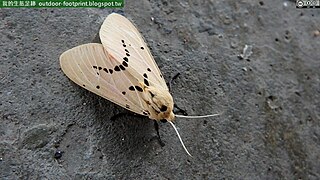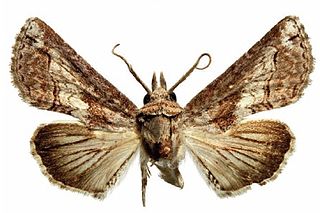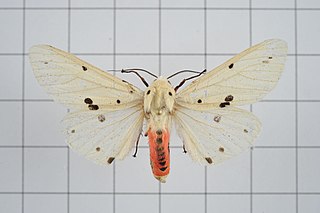
The buff ermine is a moth of the family Erebidae. It is sometimes placed in the genus Spilosoma. The species was first described by Johann Siegfried Hufnagel in 1766. It is found throughout the temperate belt of the Palearctic region south to northern Turkey, Georgia, Kazakhstan, southern Siberia, eastern Mongolia, Amur Region, China, Korea and Japan.

The Thyrididae comprise the family of picture-winged leaf moths. They are the only family in the superfamily Thyridoidea, which sometimes has been included in the Pyraloidea, but this isn't supported by cladistic analysis.

The Spilosomina are a subtribe of tiger moths in the tribe Arctiini, which is part of the family Erebidae.

Spilarctia is a genus of moths in the family Erebidae. The genus was erected by Arthur Gardiner Butler in 1875.

Euteliidae is a family of moths in the superfamily Noctuoidea. The family was erected by Augustus Radcliffe Grote in 1882.

Spilosoma obliqua, the jute hairy caterpillar or Bihar hairy caterpillar, is a moth of the family Erebidae. It is found in south-eastern Afghanistan, northern Pakistan, India, Bhutan, Bangladesh and Myanmar.
Spilarctia todara is a moth of the family Erebidae. It was described by Frederic Moore in 1872. It is found in eastern India.
Spilarctia leopardina is a moth in the family Erebidae. It was described by Vincenz Kollar in 1844. It is found in Tibet, Nepal, the north-western Himalayas and Kashmir.
Spilarctia seriatopunctata is a moth in the family Erebidae. It was described by Motschulsky in 1861. It is found in Russia, China, Korea and Japan.
Spilarctia nydia is a moth in the family Erebidae. It was described by Arthur Gardiner Butler in 1875. It is found in Nepal, China, Taiwan and northern Vietnam.

Spilarctia alba is a moth in the family Erebidae. It was described by Otto Vasilievich Bremer and William Grey in 1853. It is found in China, Taiwan and Korea.
Spilarctia bipunctata is a moth in the family Erebidae. It was described by Franz Daniel in 1943. It is found in Yunnan and Sichuan in China.
Spilarctia comma is a moth in the family Erebidae. It was described by Francis Walker in 1856. It is found in Tibet in China and in Bhutan.
Spilarctia mona is a moth in the family Erebidae. It was described by Charles Swinhoe in 1885. It is found in southern India.

Spilarctia subcarnea is a moth in the family Erebidae. It was described by Francis Walker in 1855. It is found in Nepal, China, the Russian Far East, Korea, Japan and Taiwan.
Spilarctia cervina is a moth in the family Erebidae. It was described by Hans Daniel Johan Wallengren in 1860. It is found on Sumatra and the Mentawai Islands of Indonesia.
Spilarctia rubescens is a moth in the family Erebidae. It was described by Francis Walker in 1855. It is found in Myanmar, China (Yunnan) and on Sumatra.
Spilarctia strigatula is a moth in the family Erebidae. It was described by Francis Walker in 1855. It is found in Sundaland, Thailand, Nepal and Myanmar.







